Monitoring Assets and Loans
In This Chapter:
• Understanding assets and debts
• Creating asset and debt accounts
• Adding and disposing of assets
Assets and debts (or liabilities) make up your net worth. Bank and investment accounts, as discussed in earlier chapters, are examples of assets. Credit card accounts, as covered in Chapter 5 are examples of debts or liabilities. However, you may want to use Quicken Personal Finance Software to track other assets and debts, including your house or family car, as well as any loans related to those assets. By including these items in your Quicken data file, you can quickly and accurately calculate your net worth and financial fitness.
This chapter explains how to set up asset and debt accounts to track your possessions and any outstanding loans you used to purchase them.
 The Basics
The Basics
Before you begin, it’s a good idea to have a clear understanding of what assets, debts, and loans are, and how they work together in your Quicken data file.
Understanding Assets and Debts
An asset is something you own. Common examples are your house, car, computer, smart phone, television set, and furniture. Most assets have value—you can sell them for cash or trade them for another asset.
A debt is something you owe—often to buy one of your assets! For example, if you buy a house, chances are you’ll use a mortgage to finance it. The mortgage, which is a loan that is secured by your home, is a debt. You can use Quicken to track all of your debts so you know exactly how much you owe at any given time.
Reviewing Loans
A loan is a promise to pay money. Loans are commonly used to buy assets, although some folks often turn to debt consolidation loans to pay off other debts. You can learn more about paying off current debt in Chapter 13.
While most people think of a loan as something you owe (a debt), a loan can also be something you own (an asset). For example, say you borrow money from your brother to buy a car. In your Quicken data file, the loan is related to a debt—money that you owe your brother. In your brother’s Quicken data file, the loan is related to an asset—money that is due to him from you.
There are several types of loans, some of which are designed for specific purposes.
• Mortgage is a long-term loan secured by real estate.
• Balloon mortgage is a special type of short-term mortgage. Rather than make monthly payments over the full typical mortgage term, you pay the balance of the mortgage in one big “balloon” payment.
• A home equity loan or second mortgage is a line of credit secured by the equity in your home—the difference between the home’s market value and the amount of outstanding debt.
• Reverse equity loan (sometimes called a reverse mortgage) provides people who own their homes with a regular monthly income. The loan is due when the home is sold, usually after the death of the homeowner.
• Auto loans are loans secured by a vehicle, such as a car, truck, or motor home.
• Personal loans are unsecured loans that require no collateral. Monthly payments are based on the term of the loan and the interest rate applied to the principal.

“Payable” is an accounting term that means you have an obligation to pay the amount in this account to someone.
When applying for a loan, a number of variables have a direct impact on what the loan costs you, now and in the future. Ask about all of these things before applying for any loan.
Interest Rate
The rate of interest you pay for borrowing someone else’s money is the annual percentage applied to the loan principal. Several factors affect the interest rate you may be offered:
• Your credit record, the type of loan, the term of the loan, and even your location affect the interest rate offered. Generally speaking, personal loans have the highest interest rates, while mortgage rates are usually the lowest.
• The amount of the down payment affects the interest rate offered, because the more money you put down on the purchase, the lower the rate may be.
• The lender affects the interest rate offered, because rates also vary from one lender to another. Certain types of lenders have lower rates than others. Two kinds of interest rates can apply to a loan, a fixed rate which applies the same rate to the principal throughout the loan term and a variable rate that applies different interest rates throughout the term of the loan.
Term
A loan’s term is the period of time between the date of the start of the loan and when the date payment is due in full. Loan terms vary depending on the type of loan:
• Mortgage loan and home equity reserve loan terms are typically 10, 15, 20, or 30 years. Home equity reserve loans are also known as home equity lines of credit (HELOC) or second mortgages.
• Balloon mortgage loan terms are typically 5, 7, or 10 years.
• Vehicle loan terms vary from 3 to 7 years.
Tips for Minimizing Loan Expenses
Borrowing money costs money. It’s as simple as that. However, you can do some things to minimize the cost of a loan.
• Shop for the lowest rate.
• Minimize the length of the loan.
• Maximize the down payment.
• Make extra loan payments.
• Ensure your credit history is cleaned up.
• Monitor your credit score with Quicken’s Credit Score utility as discussed in Chapter 5.

When evaluating the dollar impact of different loan deals, use Quicken’s financial calculators. Chapter 12 explains how to use these tools, including the Loan and Refinance Calculators. To access these calculators, click the Planning tab and then the Planning Tools button.
 Creating Property and Debt Accounts
Creating Property and Debt Accounts
To track an asset or debt with Quicken, you must set up an appropriate account. All transactions related to the asset or debt are recorded in the account’s register. In this section, you’ll learn about the types of accounts you can use to track your assets and debts, and how to set up each type of account. Quicken offers the following Property & Debt account types for tracking assets and debts.

• House A house account is used for recording the value of a house, condominium, or other real estate. When you create a house account, Quicken asks whether there is a mortgage on the property. If so, you can have Quicken create a related debt account for you or associate the house account with an existing debt account. This makes it possible to set up both your house asset account and mortgage debt account at the same time.
• Vehicle A vehicle account is similar to a house account, but is designed for vehicles, including cars, trucks, and recreational vehicles. Quicken asks if there is a loan on the vehicle; if so, it can create a related debt account or link to an existing debt account.
• Other Asset An asset account is for recording the value of other assets, such as personal property. For example, a Quicken data file might include asset accounts for your workshop and its related equipment, your antique china collection, or other personal possessions.
• Loan A loan account is for recording money you owe to others. As mentioned earlier, when you create a house or vehicle account, Quicken can automatically create a corresponding loan account for you. You may also create a loan account for money you lend to others. See “Creating a Lender Loan” later in this chapter.
• Home Equity Line of Credit (HELOC) This type of loan uses the borrower’s real property as collateral.
• Other Liability (not a credit card) You can create a debt account to record other debts that are not related to the purchase of a specific asset. Debt accounts show in the Account List as liabilities.
Data Needed for Asset and Debt Accounts
Earlier chapters explain how to use the Quicken Add Account dialog to create new Quicken banking accounts. This section provides information about the kinds of data you need to enter to create asset and debt accounts. To add a new asset or data account, you need the following:
• Account Type The Add Account dialog displays a list of asset types: House, Vehicle, or Other Asset in the Property & Assets section.
• Account Name Give the account a name that clearly identifies the asset or debt. Be descriptive. “Ford Focus” and “Dodge pickup” do a better job identifying the cars than “Car 1” and “Car 2.”

When creating a debt account, you may want to include the word “mortgage,” “loan,” or “payable” in the account name so you don’t confuse it with a related asset.
For house and vehicle accounts, Quicken prompts you to enter information about the asset’s purchase, including the acquisition date and purchase price. You can find this information on your original purchase receipts. Quicken also asks for an estimate of the current value. For a house, this number will (hopefully) be higher than the purchase price; for a car, this number will probably be lower.
This amount appears as the asset account balance. For other assets and debts, Quicken prompts you for a statement date and balance. If you don’t know how much to enter now, you can leave it set to zero and enter a value when you know what to enter. You will see how to adjust asset values later in this chapter.

You can use Quicken’s Attachment feature (covered in Chapter 5) and your scanner to save images of an asset’s paperwork, such as the receipt, the warranty, or delivery verification you received to store as a digital image with your Quicken data file.
Related Mortgage or Loan
As mentioned earlier, when creating a house or vehicle account, Quicken asks whether there is a related mortgage or loan. You have four options:
• Yes. I’d Like To Track This Mortgage/Loan In Quicken. Set Up A New Account For This This option tells Quicken that there is a related loan and that Quicken should create a debt account.
• Yes. I’m Already Tracking The Mortgage/Loan In Quicken This option enables you to select an existing debt account to link to the asset.
• Yes. I Do Not Want To Track the Mortgage/Loan In Quicken This option tells Quicken that there is a loan but you don’t want to include it in your Quicken data file.
• No This option tells Quicken that there is no loan, so no debt account is necessary. (Lucky you!)
As you’ve probably guessed or noticed, the use of the word “mortgage” or “loan” in this dialog depends on whether you’re creating a house or vehicle asset account. To select any of the Yes options, you must click Yes and then choose one of the options beneath it. Otherwise, choose the No option. If you selected No and clicked Next, a message appears that an account has been added, as discussed next in “Creating Asset and Debt Accounts.” Click Finish to close the dialog.
Creating Asset and Debt Accounts
You create asset and debt accounts with the same Add Account dialog you used to set up your banking accounts. Quicken offers a number of ways to open this dialog for an asset or debt account, as well as several types of assets, loans, and debts. In the following example, we are adding a new vehicle asset. The specific steps are as follows:
1. From the Account Bar, click Add An Account.
2. From the Add Account dialog, choose Property & Assets | Vehicle.
3. The Add Vehicle (Asset) Account dialog appears with the name field highlighted and ready for you to enter a new name. Type a descriptive name for the vehicle and click Next.
4. Enter the Vehicle Make/Manufacturer’s name. Press TAB.
5. Enter the Vehicle Model name.
6. Press TAB to go to the Vehicle Year field and enter that information. Continue through the dialog, pressing the TAB key to move from field to field, as seen here. When you have entered all of the information, click Next to continue. Note that the Make and Model fields are not required and, once you click Next, there is no Back button with which you can return to this screen. However, you can edit the account details after you have completed entering the information.
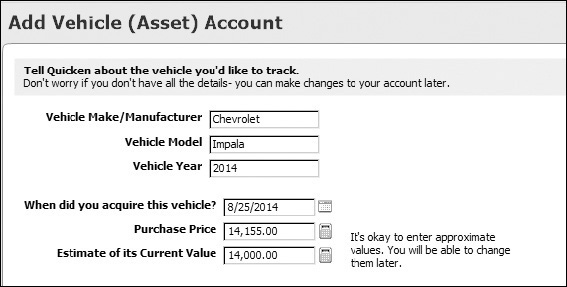
7. You are then prompted to tell Quicken about any loans (or mortgages if the asset is real property) on this asset. If there is no loan associated with this asset, click that option. If there is no loan, or you do not want to track a loan through Quicken, click No. Or, if there is a loan but you do not want to track it in Quicken, click Yes and then choose the I Do Not Want To Track The Loan In Quicken option. Click Next to continue.
8. The Account Added dialog appears with the name of your new asset shown with a green check mark. Click Finish.

A loan is actually a debt account that has special Quicken features attached to it. Use this option to set up a debt associated with a compounding interest loan, like a mortgage or standard car loan, as explained later in this chapter.
Optional Tax Information
For asset and debt accounts, click the Tax Schedule button on the Account Details dialog to enter tax schedule information for transfers in and out of the account. While this information is optional, check with your tax professional to see if this information will benefit your tax position. Chapter 14 explains how to set up Quicken accounts and categories to simplify tax preparation.

You can get to the Account Details dialog by pressing CTRL-A and then clicking the Edit button for the account with which you wish to work.
Loan Information
If you indicated that Quicken should track a loan for a house or vehicle, it automatically displays the Add Mortgage/Loan Account dialog, which you can use to enter information about the loan. If you set up a debt account, Quicken asks if you want to set up an amortized loan to be associated with the debt. If you selected Yes and I’m Already Tracking The Loan In Quicken, select the debt account from the drop-down list and click Next. You’ll then see the Account Added screen with the green check mark near the new account’s name. Quicken links the asset and debt accounts for you. See how to set up a loan later in this chapter, in the section “Creating a Loan.”

Be sure to select the appropriate type for your loan so the appropriate interest category is associated with it.
Viewing the Asset or Debt Account Register
When you’re finished setting up an asset or debt account (and related loans and loan payments, if applicable), Quicken automatically displays the account’s register. Figure 9-1 shows what a house account might look like. The first transaction, dated 4/2/1999, shows the opening balance, which was the amount paid for the house. The next transaction, dated 1/1/2005, shows an adjustment created when the homeowner received the property tax statement and entered the value shown on that statement as of 1/1/2005. The next adjustment was five years later, showing a reduction of the property’s worth, and the last entry, dated 1/1/2014, noted an increase the property’s worth as reported on the property tax statement.

Figure 9-1 • Like other accounts in Quicken, assets and debts have their own account registers.

The register in Figure 9-1 shows with a two-line display. To change your display from the default one-line display, press CTRL-2, which is a toggle between Quicken’s default one-line register display and the two-line display shown.
After you have entered more than one asset account, you’ll note that the new accounts are listed alphabetically. In earlier versions of Quicken, the new accounts went to the bottom of the appropriate section in the Account List. Many Quicken users prefer to see their accounts in alphabetical order in the Account List, and this is in response to those requests. This auto-sorting only works if you have never rearranged your account order.
All transactions that affect an asset or debt account’s balance appear in the account register. Learn more about using account registers for asset and debt accounts later in this chapter, in the section “Other Asset Transactions.”
 Loan Accounts in Quicken
Loan Accounts in Quicken
Quicken makes it easy to track the principal, interest, and payments for a loan. Once you set up a loan and corresponding debt or asset accounts, you can make payments with Quicken using QuickFill, Scheduled Transactions (transaction reminders), or Online Payments (see Chapter 6). The Loan feature keeps track of all the details for you.
Just so you know, a loan in Quicken is not the same as an asset or debt account. Quicken uses the loan information to calculate the amount of interest and principal due for each payment of an amortized loan, such as a mortgage or car loan. A loan must be associated with an asset account (if you are a lender) or a debt account (if you are a borrower), as well as an income or expense category to record either interest income or expense.
Creating a Loan
You can set up a loan in the following ways:
• Create a house, vehicle, or debt account with a related mortgage or loan, Quicken automatically prompts you for loan information.
• From the Account Bar, click Add An Account and choose Property & Debt | Loans & Debt | Loan.
• From the menu bar, click Tools | Add Account | Property & Debt | Loans & Debt | Loan.
• From the Property & Debt tab, click Debt | Loan And Debt Options | Add A New Loan.
• Also from the Property & Debt tab, click Property, click Property Options, and then click Add A New Loan.
Depending on the location from which you start, Quicken displays either the Add Account or the Add Loan Account dialog. While the information is basically the same, the type of loan does matter so that you get the right interest category type. The interest category type cannot be changed after it is entered. If this is the first time today that you have accessed any online features, Quicken updates the financial information.
If you choose to create a loan account for which you will enter the information manually, click the Manual Loan Account link at the bottom of the dialog. The illustrations that follow are for a manual account.

Be aware! If you choose to download your loan transactions, your loan account register will be read-only and will not be accessible to review and make corrections. Don’t do it! Downloading one possibly incorrect transaction per month that cannot be corrected is just not worth it. Set up your loan manually—you will be much happier!
Loan Details
The Loan Details dialog starts by prompting you for the name of the loan, as seen in Figure 9-2. The first choice is the type of loan for which you are creating an account. Click the downward arrow to choose from a list, as shown at right. Choose wisely—you cannot change the loan type or the associated loan interest type category later!
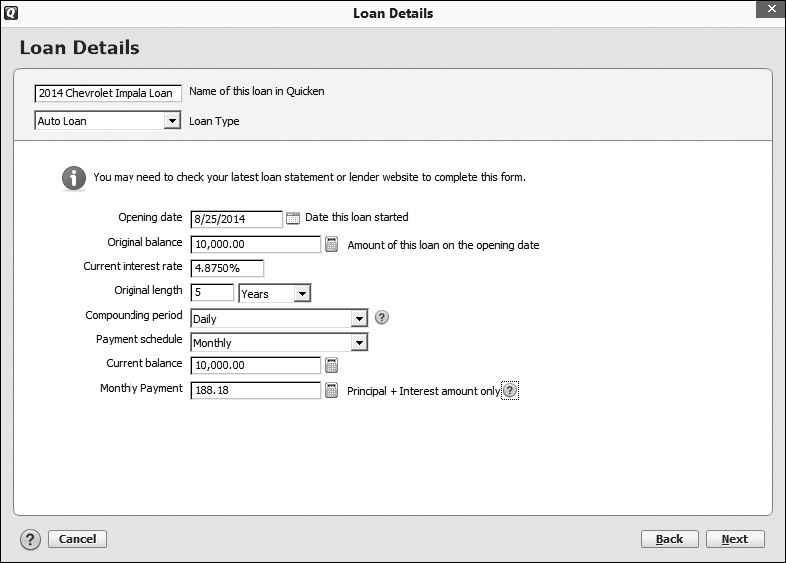
Figure 9-2 • When you create a loan account, Quicken asks for all of the details.
You have the following loan types from which to choose:
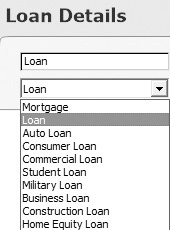
• Mortgage is a loan for some type of real property such as a house.
• Loan is for any type of loan not included in the other options. This loan type may be used for loans from individuals rather than financial institutions, such as borrowing $5,000 from your sister toward some vacation property you will both share.
• Auto loan is for vehicle loans, including trucks and travel trailers.
• Consumer loans are funds borrowed by a “person,” rather than a business. Lenders for this type of loan are usually financial institutions.
• Commercial loans are normally loans to a business from a financial institution. Such loans are often for large purchases, working capital, or real property.
• Student loans are used for financing education.
• Military loans are designed specifically for those in the service of our country.
• Business loans are usually for the day-to-day operating costs of a business, rather than for large real property or equipment purchases.
• Construction loans are used when you build a house. These loans are often turned into mortgage loans when construction is completed.
• Home equity loans are loans against the equity you hold in your home. Many people use home equity loans to pay for major remodeling, although some home equity loans are taken to pay off other, higher cost debt.
You are asked for information about the opening date, the original balance, the current interest rate, the original contract length, payment schedule, and so on, as seen in Figure 9-2. It’s important to be accurate; get the dates and numbers directly from your loan statement or agreement if possible. Quicken calculates the amount of payment and the interest based on the entries you make, as well as the extra principal, any balloon payment, and the number of remaining payments.

While Quicken’s default compounding period is Monthly, most financial institutions compound interest daily and post it to your account every month. Use the Compounding Period drop-down list to choose Daily if your lender compounds interest daily.
Click Next to continue. The Loan Details dialog continues with the name of the loan at the top, as shown here. It displays the next payment due date for this loan, based on the opening date you entered in the first screen of the dialog. You may change this date if necessary. Enter any additional information.
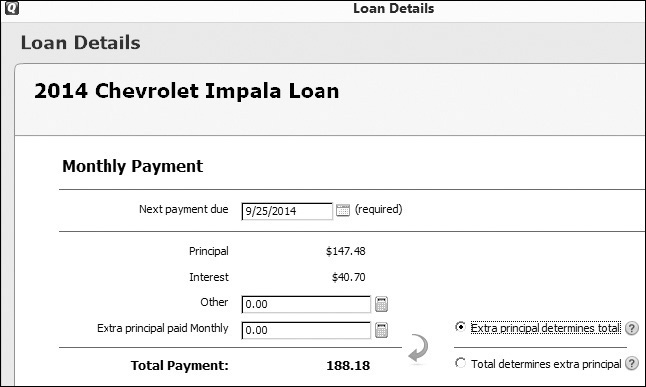
• Other is used for additional payment on the loan such as escrow funds.
• Extra Principal Paid Monthly amounts are those additional principal payments you enter to reduce the total amount of the interest you will pay on the loan.
Select the Extra Principal Determines Total radio button if you want to determine the amount of the extra principal payment you make each month as seen below. When you enter an amount, the new monthly payment appears in the Total Payment field. In our example, because we want to pay exactly $225.00 per month, we will pay an additional $36.82 to make the payment exactly $225.00.
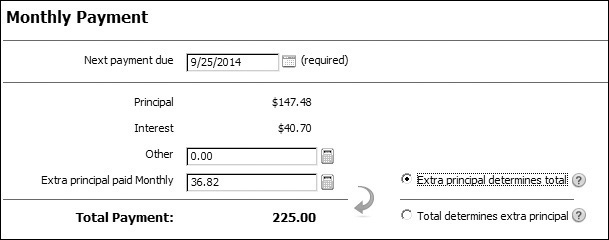
Select the Total Determines Extra Principal if you want to set the total payment each month and let Quicken determine how much extra principal will be paid as seen in the following illustration.
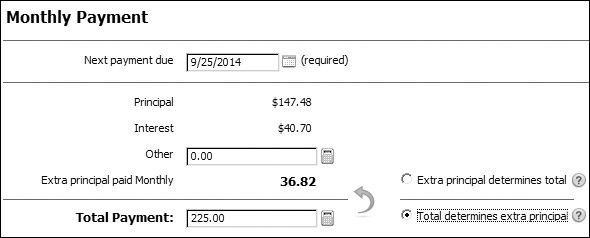
Click Next to continue. The Loan Reminder dialog appears as discussed next.
Loan Reminder
When you set up a loan, Quicken creates a reminder. From this dialog, you can tell Quicken to enter the reminder into the register automatically and choose the number of days before the due date that you want the transaction entered. If you do not want Quicken to enter the transaction automatically, leave that check box clear and click Next.
The Loan Payment Reminder dialog appears. You may edit each field as explained here:
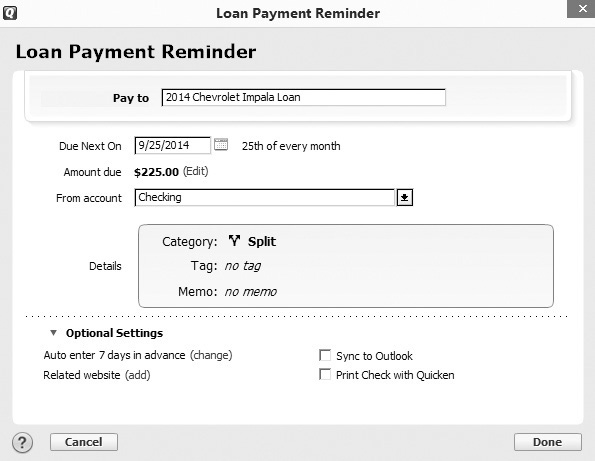
• The Pay To field shows the name of the loan if you have indicated that you will enter transactions manually to this loan account. Otherwise, it displays the name of the financial institution from which you borrowed the money. Edit this field by highlighting what appears and typing over the highlighted area.
• The Due Next On date can be changed by typing in a new due date.
• The Amount Due field originally shows the information you entered in the previous Loan Details dialog. Click Edit to see a split transaction dialog. You may change only the extra amount, not the principal or interest portions of the payment. Click Cancel or OK to close the Split Transactions Dialog. Learn more about split transactions in Chapter 5.
• The From Account field indicates the account from which the payment will be paid. Click the downward arrow to change to another account.
• You can change or add to three areas in the Details section.
• Click anywhere in the Details section to open the dialog shown here. From this one dialog, you can change the split categories, create a tag or edit an existing tag, and create a memo for each payment. Note that you have to click the Split symbol in this dialog to make changes to either the Category or the Tag field.
• When you have made your changes, click OK to close the Details dialog.

• Click Optional Settings to
• Set how many days in advance of the payment’s due date Quicken should remind you of the payment. The default is 7 days. Click Change to set another time.
• Click Related Website to enter a website. This might be the website of your financial institution or any other website that pertains to this loan. This is not required, but can be useful. If you have not yet entered a website, the link will be labeled Add. If you have entered a website, the link will be labeled Change.
• Click the Sync To Outlook check box to synchronize your payment date in your Outlook calendar.
• Click Print Check With Quicken to let Quicken know you will be paying this payment with a Quicken check.
Click Done to close the Loan Payment Reminder dialog. A message appears asking if this loan is to be associated with an asset. Click Add Linked Asset Account if you want to create an asset account for this loan. From the menu that appears, you can choose from a Home, an Auto, Other, or click Existing Account to link this loan to an existing asset.
If you choose to add a new asset account, the Add Account dialog appears. If you choose an existing asset, you will see a small icon and the information that this loan is linked to the asset you chose as seen here. The link icon depends on the type of asset. For example, for an auto loan, the icon is a car. Click Done to close the dialog.
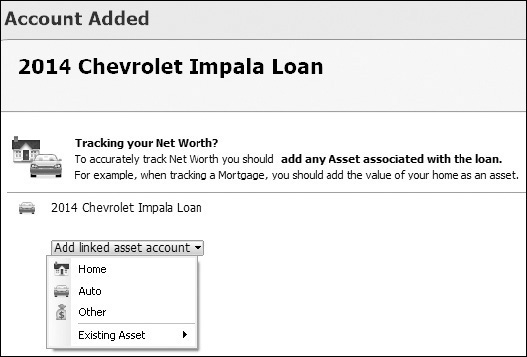
Creating a Lender Loan
From time to time, you may be in a position to lend money to someone else. Quicken calls this type of loan a Lender Loan. You create this type of account in a slightly different way.
Once you have completed all the necessary paperwork and everything is signed and notarized, you are ready to set up the account. Quicken treats this type of loan as an asset, with the value of the asset equal to the amount of money you are lending.
1. Click Add An Account at the bottom of the Account Bar. Choose Property & Debt | Property & Assets | Other Assets to open the Add Asset Account dialog.
2. Enter a name for the account. Depending on the Quicken edition you use, you may have to choose the purpose for the account, such as Personal or Business. Click Next.
3. Enter the date on which you want Quicken to start tracking this loan, which is usually the opening date of the loan.
4. Enter the asset value, usually the total amount you are lending.
5. If the loan has tax implications, click the Tax button to enter any pertinent information. Otherwise, click Next to continue.
6. The Is There A Loan On This Asset? dialog appears. Select No and click Next and then in the final dialog, click Finish.
7. Your new loan account appears in the Account Bar. Open the account to the register. You can open the account to the register by clicking the account name in the Account Bar.
8. Click the Account Actions gear icon and select Convert To A Lending Loan, as seen next. Click Convert This Asset To A Lending Loan.
9. The Loan Details dialog appears as discussed in the “Creating a Loan” section, earlier in this chapter. Complete the information, including the current interest rate, original loan length, and payment schedule. Click Next.
10. Make any additions or changes to the monthly payment in the dialog that appears and click Next again.
11. Make your choices in the Reminder dialog and click Next. At the final Reminder dialog, make any necessary changes and click Done. Your new asset account appears with loan information rather than a register. To see the transactions, click Payment Details.


Even if you are lending money to a relative, it is important that paperwork be created and signed by all parties, and in most cases, reviewed by a legal or accounting professional.
Viewing Loan Information
All loans are associated with asset and/or debt accounts. To view a loan, it must first be set up in Quicken. After you have set it up, you can access the loan information in two ways:
• Click on the loan name in the Account Bar.
• Click Tools | Account List and select the name of the account with which you want to work.
• The loan information window appears as seen in Figure 9-3.
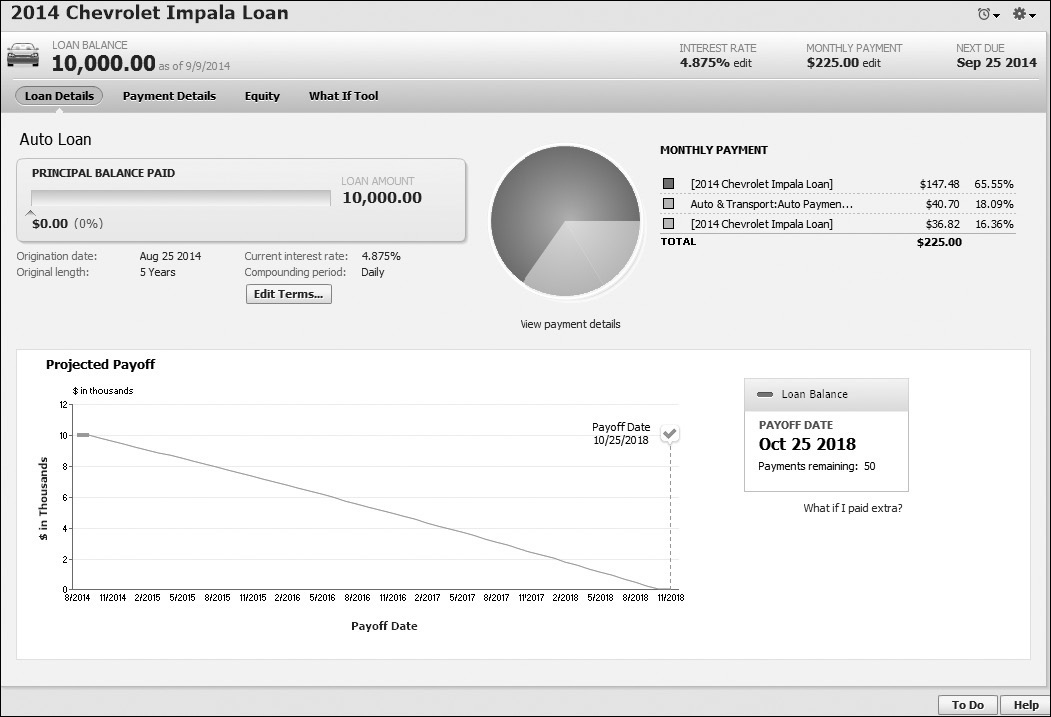
Figure 9-3 • Use the loan account window to view and edit information about that loan.
Making Loan Payments
When you first set up your loan, you told Quicken to create either a loan reminder or a memorized payee, or in some cases, both. Each time you make a payment on a loan, Quicken keeps track of the current loan balance in that loan account. If you have linked an asset to your loan, Quicken tracks your current equity as well. You can make a loan payment in several different ways, each of which is explained here:
• Use A Loan Reminder If you instructed Quicken to set up a reminder for your loan payment each month (or other payment schedule), Quicken displays a message reminder. If you have asked Quicken to include the reminder in your register, the payment is already there.
• Enter the Loan Payment Directly You can quickly enter any loan payment into your register by simply typing the payee name, and the information from your special loan payment memorized payee will appear. If you have not memorized the payee, complete the payment entry, and Quicken memorizes both the payee and the transaction so you can use that information each time you make a payment. To create the special memorized payee:
• Click the Edit link at the right of the Monthly Payment amount shown at the upper right of the loan account screen. Choose Payment Options and click Memorized Payee.
• Click OK to close the dialog.
• Use the Enter Loan Payment Option To enter a payment, click the loan account name in the Account Bar to open the loan. Select the Account Actions gear icon, and from the menu choose Enter Loan Payment, as shown here. You can also use the Customize Action Bar to add the Enter Loan Payment button to your account Action Bar.
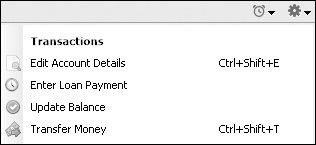

If you have elected to use the special memorized payee to make your loan payments, you will no longer see the Enter Loan Payment option in the Account Actions menu.
• Create A Quicken Toolbar Button Use the special memorized payee to create a customized Quicken Toolbar button to make your payment.
• Right-click the Quicken Toolbar and choose Customize Toolbar.
• From the Customize Toolbar dialog, select the Show All Toolbar Choices check box.
• In the Available Toolbar Buttons list, select Use A Specific Memorized Payee.

• Click Add to open the Assigned Memorized Payee To Action dialog as seen here.
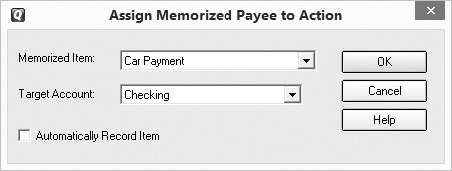
• Choose the appropriate payee from the Memorized Item drop-down list. Enter the account from which this payment will be made and select the Automatically Record Item check box if desired.
• Click OK to close the dialog and click Done to close the Customize Toolbar dialog. Your new button appears on the Quicken Toolbar as seen here.

When it’s time to enter the payment, click your new toolbar button. The Confirm Principal And Interest dialog appears. Make any changes necessary and click OK. Your payment is posted into your register.
Modifying Loan Information
Once you’ve created a loan, you can modify it as necessary to record corrections, changes in the interest rate, or changes in payment methods. You can do all these things by clicking the account name in the Account Bar and choosing the Loan Details or Payment Details tab.

You can also open a loan account window by choosing Tools | Account List and selecting the appropriate account.
At the top of the account window, you see the current balance, interest rate, monthly payment, and the next due date as seen in Figure 9-3. Should you want to make changes to either the interest rate or the monthly payment, click the Edit button to the right of that item. You also have four tabs from which you can view both loan and payment details, the current equity, and a What If tool to help you make decisions about this loan. (See “The What If Tool” later in this chapter.)
Changing Loan Information
Should you need to make changes to other parts of the loan information, use the Loan Details window to compare the data with the information found on statements or loan agreement papers. You can then make any necessary changes to other parts of the loan information, such as the original balance or payment schedule, as explained next.
From the Loan Details tab in your loan account window, select Edit Terms. The Loan Details dialog appears.
Modify values and select different options as desired.
• Opening Date Usually, this is the date the loan started.
• Original Balance Use your loan statement papers to find this balance if you didn’t enter it when you set up the account.
• Current Interest Rate This can vary, depending on your loan.
• Original Length See the original loan papers for the length of your loan.
• Compounding Period While Quicken defaults to Monthly, normally banks and other lending institutions compound interest daily. Change this to Daily if that is true for this loan.
• Payment Schedule This will often be monthly, although some loan terms have quarterly, semi-annual, or even annual payment schedules.
• Current Balance Use the latest statement for this balance.
• Recalculate This button may appear if you have changed any of the information.
• Monthly Payment This is the total of principal and interest and does not include any other fees.
• Recalculate You may see an additional recalculate button beneath the Monthly Payment, if you have made any changes.
Click OK to save your changes. If you have made any adjustments, you may see a message stating that Quicken has recalculated based on the information you entered.
Viewing Payment Details
The second tab in the loan account window is Payment Details. To review or modify the payment details, you can either:
• Click the Payment Details tab.
–Or–
• Click View Payment Details under the pie graph in the top center of the loan account window.
In either case, the Payment Details window appears as seen in Figure 9-4.
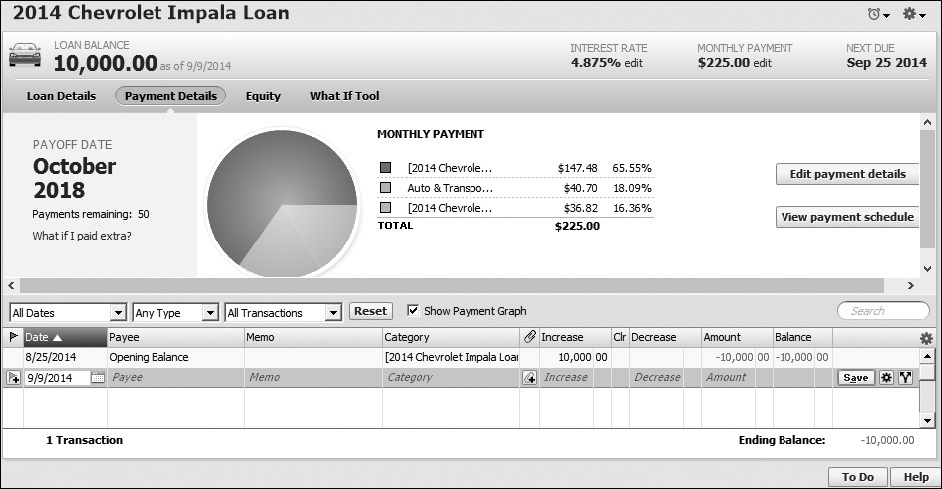
Figure 9-4 • The Payment Details window in a loan account has both current payment information and a register showing the latest payments on the account.
The snapshot at the top of the Payment Details tab is a graph that shows the current monthly payment for this loan, broken down by interest and principal. Click the Edit Payment Details button to make any changes to the monthly payment. Click OK or Cancel to close the Edit Payment Details dialog.
At the upper right of the Payment Details window is the current payoff date for the loan, as well as the number of payments remaining to be paid. Underneath the number of payments is a link to the What If tool, entitled What If I Paid Extra. See “The What If tool” later in this chapter for more information.

The current payoff date, number of payments remaining to be paid, and the What If I Paid Extra link are on the left side of the Payment Graph. If you have the Show Payment Graph check box unchecked, you will not see any of this data.
The Full Payment Schedule Click the View Payment Schedule button at the top-right of the Payment Details window when the Show Payment Graph box is checked. This information is based on your current Loan Details and Loan Payment. You can also add the View Payment Schedule button to the account Action Bar.
Click the printer icon to print the report to your default printer. Click Done to close the dialog.
Payment Detail Register The register at the bottom half of the Payment Details window shows each principal payment that was made on this account since the loan began. The payments that show on this register are only the principal amounts. To see the entire payment, go to the account register from which the payment was made. You can change what shows in this register by choosing the filter drop-down lists at the top of the register.
You can clear the graph to show more payments in the register. Click the check box to the left of Show Payment Graph to toggle the graph on and off.
If you are on a laptop or just have your monitor resolution set to the Quicken minimum, you may see only one transaction line at a time. You can see more transaction lines by toggling to a one-line display (CTRL-2), maximizing the register (F11), or setting your preferences to use pop-up registers (Edit | Preferences | Register | Register Appearance | Use Pop-up Registers).
• The Dates drop-down list allows you to select the date range you want to see in the register.
• The Types and Transactions lists let you tailor the register to your needs.
• The Reset button returns the filters to their default settings.
Retaining the filters for future Quicken sessions is a preference. Click Edit | Preferences | Register | Register Appearance | Remember Register Filters After Quicken Closes.
The Equity Button
Click the Equity button to see information about this loan and its associated asset as well as the current net value or equity in the asset. As seen here, if there is more than one loan associated with this asset, both will be displayed.

The amount of your equity in this asset is shown as both a percentage and a net value. If you click on the link to the left of Net Value, a small graph appears showing the change in your equity over the last year.
• Click the Options gear icon at the right of the Equity graph to customize the graph. You can also click the Help Reduce My Debt link to be taken to the Debt Reduction dialogs. See Chapter 13 to learn about budgets and debt reduction in Quicken.
• Click Done to close this equity dialog.
• Click the See All Properties button to view a similar graph showing all of your assets and their corresponding liabilities.
The What If Tool
The What If tool tab at the top of your loan account window opens a worksheet that allows you to see the effects if you made some different financial choices for this account. When the window opens, you see the What If Payoff Schedule at the right side of the window as seen here. This schedule, based on the current terms, shows the projected payoff date, total interest paid this year, total interest paid to today’s date, and the projected total interest that will be paid using your choices for paying off the loan.
Within the tool itself, you can see projected changes if you make additional payments each month or a one-time payment. In the example shown in Figure 9-5, we have chosen to pay an extra $100.00 per month with our mortgage payment. After we click the See Results button, notice the change in both the graph and the What If Payoff Schedule. By adding this $100.00, we will pay off this loan more than 7 years early and save about $5,890.36 in interest.
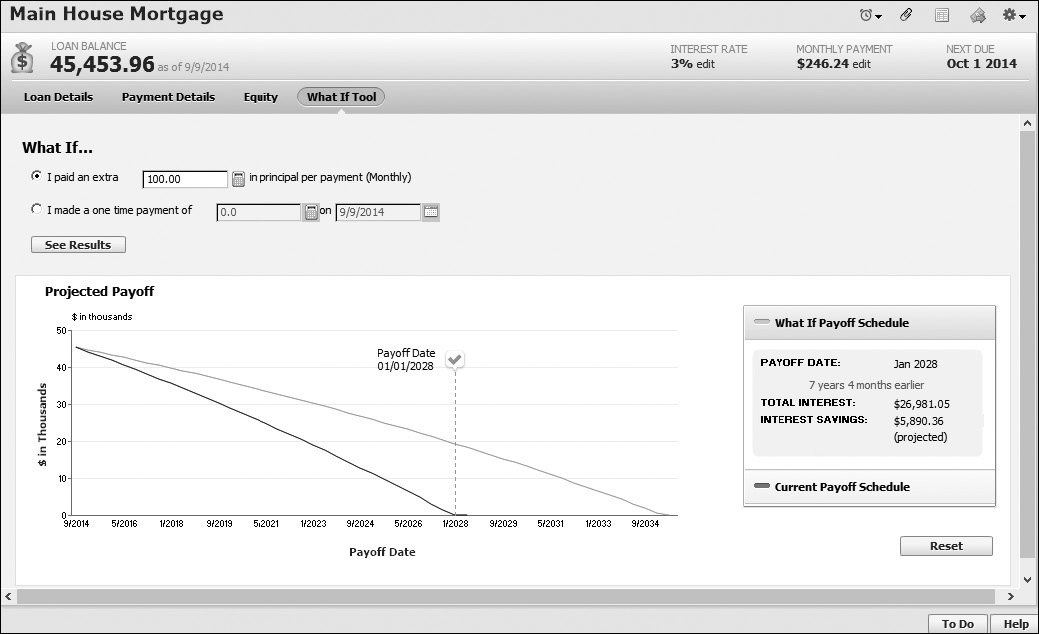
Figure 9-5 • Use the What If tool in any loan account to see the effect of additional loan payments.
You can click Current Payoff Schedule to review that information once more. Then, to see the differences again, click What If Payoff Schedule.
When you have finished working with the What If tool, click the Reset button at the lower right of the What If tool window to return to the current information, or close and reopen Quicken. The changes are not saved.
Action Gear Options
At the upper right of the loan account window is the Action gear from which you can choose from the following options, most of which are links.
• Edit Account Details Click this link to open the Account Details dialog you saw when setting up the account.
• Enter Loan Payment This link opens the Enter Transaction dialog from which you can enter a payment into the appropriate banking (or credit union) register. However, if you are using a memorized payee instead of the reminder, you will not see this dialog.
• Update Balance This option opens the Update Balance dialog, which allows you to enter a new balance for the loan and the effective date of that change.
• Transfer Money Select this option to open the Quicken Transfer Money dialog, which is discussed in Chapter 6.
• Full Payment Schedule This report is the same report shown when you click the View Payment Schedule button.
• Account Attachments See Chapter 5 to learn more about adding attachments to register entries.
• Account Overview This link opens a customizable graph showing the last twelve months of this loan.
• Print Transactions With the dialog that opens when you select this option, you can print transactions in the register for time periods you choose.
• Export to Excel Compatible File This option allows you to send the loan information to Microsoft Excel (or compatible programs).
• Reminders To Show In Register This option is the same as the Reminders icon option shown earlier in this chapter.
• Two-Line Display With this option selected, each transaction in the register shows in two lines. Clear the check box to have each transaction show on only one line.
• Sorting Options This link lets you sort by 11 additional alternatives in addition to the default Date sort.
• Register Columns Use this link to tell Quicken what columns you want to see in your register.
• Register Preferences This option opens the Quicken Preference dialog to the Register Preferences section. See Appendix B for more information about setting Preferences.
• Customize Action Bar From this dialog, you can set the icons you wish to see in the Action Bar, next to the Action gear icon. These icons are in addition to the Show Reminders icon, which is the Quicken 2015 default.
 Other Asset Transactions
Other Asset Transactions
Part of tracking assets is keeping track of their current values and modifying account balances when necessary. Like bank or investment accounts, which are discussed in earlier chapters, activity for an asset account appears in its account register.
The best way to open an asset’s register is to click the name of the account in the Account Bar. The asset account’s register appears. If you do not see your account listed in the Account Bar, you may need to change the account’s display. Press CTRL-A to open the Account List and check the Show Hidden Accounts check box to show all of your accounts.
In this section, you’ll see how you can record changes in asset values due to acquisitions and disposals, improvements, market values, and depreciation.
Adding and Disposing of Assets
The most obvious change in an asset’s value occurs when you add or remove all or part of the asset. For example, you may have a single asset account in which you record the value of all of your sports-related equipment. When you buy a set of golf clubs, it increases the value of the account. Similarly, if you sell your small outboard motor, it decreases the value of the account.
In many instances, when you add or dispose of an asset, money is exchanged. In that case, recording the transaction is easy: simply use the appropriate bank account register to record the purchase or sale, and use the asset account in the Category field. Enclose the category in square brackets [ ].
If the asset was acquired without an exchange of cash, you can enter the transaction directly into the asset account using the Gift Received category (or a similar category of your choice) to categorize the income. Similarly, if the asset was disposed of without an exchange of cash, you can enter the transaction into the asset account register using the Gifts Given or Charity category (or other category) to categorize the write-off.
You can also just record the transaction as an internal transfer in the asset account. If the asset account name is Sports Equipment, an internal transfer in the Sports Equipment account would use the category [Sports Equipment]. You may see a prompt warning you that you are recording a transfer back into the same account. Click Yes to save the transaction.
If you have completely disposed of the asset and no longer need the account, don’t delete the account! Doing so will remove all income and expense category transactions and un-categorize all transfer transactions related to the account. Instead, consider hiding the account to get it off account lists. In addition, while you are working with hiding your accounts, be very cautious about using the Close Account feature. Closing an account in Quicken 2015 is permanent.
One of the most useful features of Quicken is the Account Attachments feature. This feature allows you to digitally attach copies of property tax statements, home improvement receipts, and other paper items that may add to the basis of your property. You can scan any of these documents and save the scanned copy in the same file with your Quicken data. See Chapter 5 for a full explanation of the process.
Updating Asset Values
A variety of situations can change the value of a single asset. The type of situation will determine how the value is adjusted. Here are three common examples.
Recording Improvements
Certain home-related expenditures are sometimes considered improvements that increase the value of your home. It’s important that you keep track of improvements, because they raise the property’s tax basis, thus reducing the amount of capital gains you may have to record (and pay tax on) when you sell the house. Your tax advisor can help you determine which expenditures can be capitalized as home improvements.
Since most home improvements involve expenditures, use the appropriate spending account register to record the transaction. Be sure to enter the appropriate asset account (House, Condo, Land, and so on) in the Category field, and enclose the account name in square brackets [ ].
Adjusting for Market Value
Real estate, vehicles, and other large-ticket-item assets are also affected by market values. Generally speaking, real estate values go up, vehicle values go down, and other item values can vary either way depending on what they are.
To adjust for market value, click the Action gear icon | Account Overview | Asset Status | Options | Update My Account Balance. The Update Account Balance dialog appears. Use this dialog to enter the market value in the New Balance field and then enter the date of this new value in the Date field. Be careful, as the default date of the change is today’s date. Click OK to close the dialog.

You can also click the Action gear icon and choose Update Balance.
When you click OK, the entry is added to the account register as a reconciled transaction. The category for this transaction defaults to Misc. You may change this category by clicking in the Category field and entering the category you want to use.
If you don’t want the adjustment to affect any category or account other than the asset, choose the same asset account as a transfer account. When you click OK, a dialog will warn you that you are trying to record a transfer into the same account. Click OK again.
Recording Depreciation
Depreciation is a calculated reduction in the value of an asset. Depreciation expense can be calculated using a variety of acceptable methods, including straight line, sum of the year’s digits, and declining balance. Normally, it reduces the asset’s value regularly, with monthly, quarterly, or annual adjustments.
Depreciation is commonly applied to property used for business purposes, since depreciation expense on those assets may be tax-deductible. If you think depreciation on an asset you own may be tax-deductible, use Quicken to track the depreciation expense. Otherwise, depreciation probably isn’t worth the extra effort it requires to track. As always, consult with your tax professional to be sure.
To record depreciation, create an entry in the asset account that reduces the value by the amount of the depreciation. Use a Depreciation Expense category to record the expense.
Keep in mind that you can set up monthly, quarterly, or annual depreciation transactions as scheduled reminders in the Bill & Income reminders. This automates the process of recording them when they are due. See more about scheduled transactions in Chapter 6.
